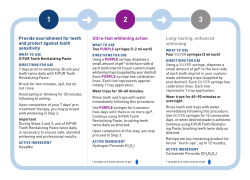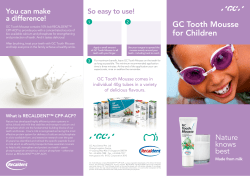
Tooth Loss in Primary and Adult Dentition and Options Available Demystified
Tooth Loss in Primary and Adult Dentition and Options Available Demystified By Dr. Jan (Ian) Kantoch DMD Primary Teeth Unlike sharks, who have what seems to be an infinite supply of teeth to facilitate eating, we as humans are blessed with only two sets of teeth throughout our lives. This being said, one can begin to believe that if we lose one baby tooth, that we will have another tooth to replace it. This is true to some degree however, it also has its own implications. What it all comes down to is timing in that having lost a baby tooth too early can cause problems and losing a baby tooth too late can cause problems of its own. There is also a small number of us who may need these baby teeth for the rest of our lives as there may be no adult teeth to replace the primary teeth. These adult teeth are termed ‘congenitally missing’. When a baby tooth is lost too early, not only is it harder for the child to chew, there is also a loss of ‘space’. What this baby tooth was doing for the child’s dentition was that it was saving for the adult tooth coming in after it. Typically, though not always, teeth like to move into empty spaces and no other is as notorious as our 6-year molars which are the first to appear in a child’s mouth. One of the most important things that baby teeth do for us humans is ‘saving a spot’ in the dental arch so that other teeth do not move into spaces that they are not supposed to. An analogy that we can use to demonstrate this is one where when some of us ride the bus, we like to save a spot for our friend who is waiting at the bus stop further down the route. Without taking up two seats on the bus, our friend is unlikely to be able to sit beside us without having an awkward conversation with an individual who has decided to occupy said seat. In terms of the permanent tooth and primary tooth relationship, what this means is that the permanent tooth which is supposed to come up under the primary tooth or an adult tooth beside it could potentially ‘sit’ somewhere it was not intended. What future implications this has for a given patient’s future dentistry is the fact that this space may need to be ‘regained’ to prevent crowding which may impact the way a given individual’s teeth function, how they appear and possible overall impact on the temporomandibular joint including chronic pain (Turp JC, 2008). What this usually means is higher possibility of orthodontic treatment in the future. There are a few ways that children can lose their baby teeth, however, dental caries plays a huge role in the loss of teeth in general. Dental caries results when a given patient is not able, for one reason or another, to maintain their teeth. And although it may seem redundant hearing this when visiting a dentist, what this entails is brushing and flossing regularly. In children especially, it may be advisable to use in a fluoride supplement. The use of a fluoride supplement should be discussed with your dentist as the need for this may vary on a case by case basis. If a patient is diagnosed with caries and the primary tooth is planned for extraction, there are still options to help maintain the space that the tooth was saving. What dentists may resort to is the use of a dental appliance called a space maintainer which can also help to save a spot for the permanent tooth. One example of how this works is that a band is glued to one of the neighboring teeth and a wire is used in order to help maintain a constant pressure on the other neighboring tooth to prevent them from moving into the space. If one were to return to the previous analogy, what this would entail is instead of having someone sitting across two seats, one would be placing their backpack to reserve the spot for their friend. This being said however, whenever there are appliances placed in the mouth, the need for appropriate oral hygiene increases as there is an increase in caries risk (Pinkham JR, 2005). Adult Teeth Now that we have discussed the importance of maintaining the baby teeth, it is important to discuss the importance of maintaining the adult teeth. As mentioned before, we only have this set of teeth as humans when we have lost the primary teeth. This is what makes it especially important to maintain the adult teeth and their associated supporting structures. Although it may seem easier to a patient to simply remove a tooth that is compromised due to caries, infection, or periodontal issues, placing any prosthesis in the mouth will never be the same as having the ’real thing’ in terms of look and feel. The main causes of adult tooth loss are periodontal disease and caries. Periodontal disease entails a loss of bone and soft tissue structure around the teeth which is responsible for their stability. There are many things that may affect the progression of periodontitis including systemic diseases, habits such as smoking, and genetics. This being said, both diseases are largely preventable with regular oral hygiene and visits to the dentist. When one does encounter tooth loss however, whether due to disease-related reasons or others, there are many options available for their replacement. This being said, most of the time it is better to try to save the natural tooth rather than trying to replace it with something that is artificial. Of course, as with these following options and anything in dentistry, this must be evaluated on a case-by-case basis and should be discussed with your dentist. The first option that is available to the patient is that of no treatment. In some cases this is a feasible treatment if the patient is happy enough with the disadvantages in that it can alter the esthetics, the functioning of the patient may be altered and the psychological well-being of the patient may be changed. The advantage of this is that there is no cost as there is no restoration to be placed in the area. The second option is a fixed partial denture (also known as a ‘bridge’) depending on the state of the neighboring teeth to the space in question in terms of mobility, structural state and oral hygiene among others. The advantage of this is the fact that it remains in your mouth and may have a less bulky feel to it. The disadvantage to this treatment is the difficulty in certain situations of maintaining it and the stress that it imparts on the neighboring teeth. The third option is that of a removable partial denture which sits in prepared ‘seats’ and uses remaining teeth throughout the arch in question for support. The advantage to these is ease of cleaning and the ability to replace multiple areas throughout the arch. The disadvantage is again the dependence on other teeth on its support which could compromise these teeth and an increase in caries susceptibility if the partial denture is not maintained properly. The fourth option, in the case of loss of all the teeth (complete edentulism) is that of a denture. The advantage of this is that all the teeth are replaced and esthetics and function can be restored to a certain degree. The disadvantages of complete dentures are the possibility of compromised retention as they are dependant on a number of structures in the oral cavity to remain in place and the loss of bone structure in the dental arch which could potentially further reduce retention of the denture and which could have been used for implant placement. The fourth option that is available to patients is that of oral implants. In a simplistic sense, these are titanium screws which integrate into the bone where a given patient’s teeth once were. The process involves procedures for the placement of the implant and possible other procedures add bone if there is a lack of bone to support the implant in the area that is being restored. The advantages to this treatment are esthetics, the maintenance of bone in the area, and the restoration is not bulky. The disadvantage to this type of treatment is the time required to restore the area as it takes time for the implant to integrate with the bone and the increased cost. The options listed are simply a summary of the possible treatments that should be discussed with your dentist and in reality entail only a fragment of the overall picture when evaluating various treatments. In the end, as stressed before, the best treatment is that where one maintains the natural dentition, whether primary or adult dentition, by maintaining a daily oral hygiene regimen using a variety of oral hygiene aids that can be suggested and provided by your local dentist. Works Cited Pinkham JR, C. P. (2005). Pediatric Dentistry: Infancy through Adolescence. St. Louis, Missouri: Elsevier Saunders. Turp JC, G. C. (2008, April). Dental Occlusion: A critical reflection on past, present,and future concepts. Journal of Oral Rehabilitation , 35 (6), pp. 446-453.
© Copyright 2025





















